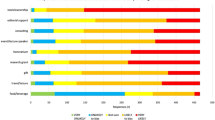Abstract
This empirical work attends to the tensions and contradictions medical students articulate when they discuss their objection to industry’s influence in medicine. Findings are based on 50 semi-structured interviews with medical students who are critical of the pharmaceutical industry’s influence in medical education in the United States and Canada. These students advocate evidence-based medicine (EBM) as one solution to the problems with industry influence in medicine; namely industry bias in medical research. This investigation is an effort to understand why EBM is posed as a solution to industry bias in light of the literature demonstrating the ways that what is considered ‘evidence-based’ is influenced by industry. Participants articulate a struggle to find the ‘best’ evidence in a context where industry interests are integral in the production of medical knowledge.
Similar content being viewed by others
Notes
The current iteration of the campaign, Just Medicine, features the slogan “No Kick Backs”. No Speakers Bureaus. No Free Samples. “JUST MEDICINE” and also seeks to “facilitate student engagement in work that promotes patient-centered, evidence-based clinical practice, medical education and research” (AMSA 2013).
Lexchin (2012) refers here to a process whereby a company or representative of a company recruits a person (or persons) to “take data from clinical trials and write an article with a ‘spin’ favourable to the drug,” then recruits an academic or doctor to pose as the author of that article (254).
References
Abraham, J. (2007). Drug trials and evidence bases in international regulatory context. BioSocieties, 2(1), 41–56. doi:10.1017/S1745855207005042.
Association of Faculties of Medicine of Canada. (2009). The Future of Medical Education in Canada (FMEC): A collective vision for MD education. http://www.afmc.ca/fmec/pdf/collective_vision.pdf.
Association of American Medical Colleges. (1998). Report 1 learning objectives for medical student education. Guidelines for medical schools. Medical School Objectives Project. http://members.aamc.org/eweb/upload/Learning%20Objectives%20for%20Medical%20Student%20Educ%20Report%20I.pdf.
Austad, K. E., Avorn, J., Franklin, J. M., Campbell, E. G., & Kesselheim, A. S. (2014). Association of marketing interactions with medical trainees’ knowledge about evidence-based prescribing: Results from a national survey. JAMA Internal Medicine, 174(8), 1283–1290. doi:10.1001/jamainternmed.2014.2202.
Borgerson, K. (2009). Valuing evidence: Bias and the evidence hierarchy of evidence-based medicine. Perspectives in Biology and Medicine, 52(2), 218–233. doi:10.1353/pbm.0.0086.
Choudhry, N. K., Stelfox, H., & Detsky, A. S. (2002). Relationships between authors of clinical practice guidelines and the pharmaceutical industry. JAMA, 287(5), 612–617. doi:10.1001/jama.287.5.612.
De Vries, R., & Lemmens, T. (2006). The social and cultural shaping of medical evidence: Case studies from pharmaceutical research and obstetric science. Social Science & Medicine (1982), 62(11), 2694–2706. doi:10.1016/j.socscimed.2005.11.026.
Goldenberg, M. J., Borgerson, K., & Bluhm, R. (2009). The nature of evidence in evidence-based medicine: Guest editors’ introduction. Perspectives in Biology and Medicine, 52(2), 164–167. doi:10.1353/pbm.0.0077.
Guyatt, G., Akl, E. A., Hirsh, J., Kearon, C., Crowther, M., Gutterman, D., & Schnemann, H. (2010). The vexing problem of guidelines and conflict of interest: A potential solution. Annals of Internal Medicine, 152(11), 738–741. doi:10.7326/0003-4819-152-11-201006010-00254.
Holloway, K. (2014). Uneasy subjects: Medical students’ conflicts over the pharmaceutical industry. Social Science & Medicine, 114, 113–120.
Lexchin, J., Bero, L. A., Djulbegovic, B., & Clark, O. (2003). Pharmaceutical industry sponsorship and research outcome and quality: Systematic review. BMJ, 326(7400), 1167–1170.
Lexchin, J. (2012). Those who have the gold make the evidence: How the pharmaceutical industry biases the outcomes of clinical trials of medications. Science and Engineering Ethics, 18(2), 247–261. doi:10.1007/s11948-011-9265-3.
Molloy, W., Strang, D., Guyatt, G., Lexchin, J., Bédard, M., Dubois, S., & Russo, R. (2002). Assessing the quality of drug detailing. Journal of Clinical Epidemiology, 55(8), 825–832. doi:10.1016/S0895-4356(02)00398-0.
Mykhalovskiy, E., & Weir, L. (2004). The problem of evidence-based medicine: Directions for social science. Social Science and Medicine, 59(5), 1059–1069. doi:10.1016/j.socscimed.2003.12.002.
Roseman, M., Milette, K., Bero, L. A., et al. (2011). Reporting of conflicts of interest in meta-analyses of trials of pharmacological treatments. JAMA, 305(10), 1008–1017. doi:10.1001/jama.2011.257.
Rycroft-Malone, J., Harvey, G., Seers, K., Kitson, A., McCormack, B., & Titchen, A. (2004). An exploration of the factors that influence the implementation of evidence into practice. Journal of Clinical Nursing, 13(8), 913–924. doi:10.1111/j.1365-2702.2004.01007.x.
Sackett, D. L. (2000). Evidence-based medicine: How to practice and teach EBM. London: Churchill Livingstone.
Timmermans, S., & Angell, A. (2001). Evidence-based medicine, clinical uncertainty, and learning to doctor. Journal of Health and Social Behavior, 42(4): 342–359. doi:10.2307/3090183
Timmermans, S., & Chawla, N. (2009). Evidence-based medicine and medical education. In C. Brosnan & B. S. Turner (Eds.), Handbook of the sociology of medical education. London: Routledge.
Author information
Authors and Affiliations
Corresponding author
Rights and permissions
About this article
Cite this article
Holloway, K.J. A Troubled Solution: Medical Student Struggles with Evidence and Industry Bias. Sci Eng Ethics 21, 1673–1689 (2015). https://doi.org/10.1007/s11948-014-9623-z
Received:
Accepted:
Published:
Issue Date:
DOI: https://doi.org/10.1007/s11948-014-9623-z



